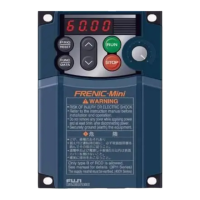9-20
Trip immediately (F14 = 0)
If an instantaneous power failure occurs when the inverter is in Running mode so that the
inverter detects undervoltage of the DC link bus, then the inverter immediately shuts down its
outputs and displays the undervoltage alarm "
NW
" on the LED monitor. The motor will coast to
a stop and the inverter will not restart automatically.
Trip after recovery of power (F14 = 1)
If an instantaneous power failure occurs when the inverter is in Running mode so that the
inverter detects undervoltage of the DC link bus, then the inverter immediately shuts down its
outputs without transferring to Alarm mode or displaying the undervoltage alarm "
NW
." The
motor will coast to a stop. When the power is recovered, the inverter will enter Alarm mode for
undervoltage.
This setting is used when you run/stop the motor by turning the inverter power on/off with any
run command being on. Turning off the controller power with the power switch will not cause
the inverter to transfer to Alarm mode or trip.
Restart at the frequency at which the power failure occurred (F14 = 4)
If an instantaneous power failure occurs when the inverter is in Running mode so that the
inverter detects undervoltage of the DC link bus, then the inverter saves the current output
frequency.
When the power is recovered with any run command being ON, the inverter will restart at the
saved frequency. During the instantaneous power failure, if the motor speed slows down, the
current limiter facility of the inverter will be activated and automatically lower the output
frequency. Upon synchronization of the output frequency and motor speed, the inverter
accelerates up to the previous output frequency. Refer to the figure (F14 = 4) on the following
page for details.
To synchronize the output frequency and motor speed, the instantaneous overcurrent limiter
(H12 = 1) should be enabled.
This setting is optimal for operations in which the motor speed rarely slows down due to the
heavy moment of inertia of its load even if the motor is coasting to a stop because of the
instantaneous power failure.
Restart at the start frequency (F14 = 5)
If an instantaneous power failure occurs when the inverter is in Running mode so that the
inverter detects undervoltage of the DC link bus, then the inverter immediately shuts down its
outputs. After the power is recovered, entry of any run command will restart the inverter at the
frequency specified by function code F23. Refer to the figure (F14 = 5) on the following page
for details.
This setting is optimal for operations in which the motor speed quickly slows down to 0 r/min
due to its heavy load with a very small moment of inertia if the motor coasts to a stop because of
the instantaneous power failure.
• There is a 0.5 second delay from detection of the undervoltage until the motor is
restarted. This delay is due to the time required for the residual electricity
(magnetic flux) in the motor to erase. Therefore, the motor will restart with a
0.5-second delay after the power is recovered, even if the instantaneous power
failure period is shorter than 0.5 second.
• When an instantaneous power failure occurs, the power supply voltage for
external circuitry (such as relay circuits) controlling the inverter may also drop as
low as to cause run commands to be discontinued.
Therefore, during recovery from an instantaneous power failure, the inverter
waits 2 seconds for a run command to arrive. If it receives one within 2 seconds,
it will restart. If a run command arrives more than 2 seconds later, then the
inverter should be restarted at the start frequency (F23). The external circuitry
should be so designed that it will issue a run command within 2 seconds in such
an event; otherwise it should incorporate a relay with a mechanical locking
feature.

